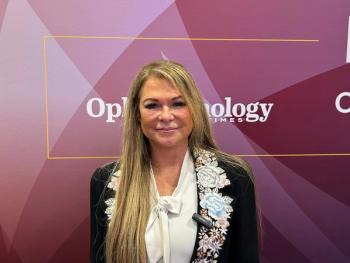
Genetics improve risk assessment in AMD
Inclusion of clinically relevant genetic markers improves the accuracy of predicting risk of progression to choroidal neovascularization (CNV) in patients with age-related macular degeneration (AMD) beyond a prediction based on only phenotypic risk factors, according to a recent cohort study.
San Diego-Inclusion of clinically relevant genetic markers improves the accuracy of predicting risk of progression to choroidal neovascularization (CNV) in patients with age-related macular degeneration (AMD) beyond a prediction based on only phenotypic risk factors, according to a recent cohort study.
“There have been many genetic, clinical, demographic, and environmental factors associated with progression to CNV in patients with AMD,” said Lorah Perlee, PhD, vice president, scientific affairs, Sequenom Inc., San Diego, Ca. “However, disease stage has been the most widely used method for anticipating risk of conversion.”
The use of a CNV prediction model-combining genotype and phenotype-allows for greater stratification of individuals within the same grade of disease and allows for individualized risk assessment based on an individual’s genetic predisposition, Dr. Perlee said.
The analyses (Ophthalmology. 2013; 120:9: 1880-1892) used data from 2,415 participants in the Age-Related Eye Disease Study (AREDS). At baseline, 940 of the patients were free of disease and 1,475 had early or intermediate AMD.
During follow-up through 10 years, 603 subjects converted to CNV.
DNA specimens from all subjects were genotyped using single nucleotide polymorphisms in genes associated with the development of CNV, including CFH and related genes, C2, C3, FB, and ARMS2.
Phenotype was assessed at baseline using the AREDS simplified severity scale-the fundus grading system stratifying patients into five risk categories for progression to advanced AMD (grade 0 to 4) based on assessment of drusen and pigment abnormalities in both eyes.
The dataset was partitioned into a training set and a validation set, which were balanced with respect to progression, age gender, and smoking status. Cox proportional hazards progression analysis was performed to assess individual disease-associated variables to generate predictive algorithms based on phenotype alone or including genotype.
In the validation testing, comparison of model accuracy for predicting CNV based on test sensitivity and specificity showed a statistically significant difference favoring the model, including genotype versus that based on phenotype alone.
The phenotype only model also provided only a single estimate for each risk category, Dr. Perlee added. For example, all subjects in the highest risk category-grade 4-would be assigned a 65% probability of developing CNV after 10 years.
“Adding genotype resulted in greater stratification within each phenotype group, reflecting that risk of progression varies depending on an individual’s genetic burden,” she said.
“Therefore, it is not surprising that we can find subjects with a grade 3 phenotype and a high genetic burden who have a higher risk of developing CNV than individuals with a grade 4 phenotype but a low genetic burden.”
For more articles in this issue of Ophthalmology Times eReport, click
To receive weekly clinical news and updates in ophthalmology,
Newsletter
Don’t miss out—get Ophthalmology Times updates on the latest clinical advancements and expert interviews, straight to your inbox.



















































.png)


